Climate Change First Became News 30 Years Ago. Why Haven’t We Fixed It?

THIRTY YEARS AGO, the potentially disruptive impact of heat-trapping emissions from burning fossil fuels and rain forests became front-page news.It had taken a century of accumulating science, and a big shift in perceptions, for that to happen. Indeed, Svante Arrhenius, the pioneering Swedish scientist who in 1896 first estimated the scope of warming from widespread coal burning, mainly foresaw this as a boon, both in agricultural bounty and “more equable and better climates, especially as regards the colder regions of the Earth.”
There were scattered news reports through the decades, including a remarkably clear 1956 article in the New York Times that conveyed how accumulating greenhouse gas emissions from energy production would lead to long-lasting environmental changes. In its closing the article foresaw what’s become the main impediment to tackling harmful emissions: the abundance of fossil fuels. “Coal and oil are still plentiful and cheap in many parts of the world, and there is every reason to believe that both will be consumed by industry so long as it pays to do so.”
For More: https://www.nationalgeographic.com/magazine/2018/07/embark-essay-climate-change-pollution-revkin/

